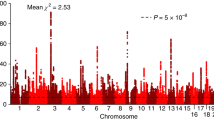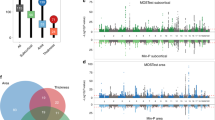Abstract
We provide an illustration of an application of the elastic net to a large number of common genetic variants in the context of the search for the genetic bases of an endophenotype conceivably related to individual differences in learning. GABA concentration in the occipital cortex, a critical area for reading, was obtained in a group (n = 76) of children aged 6–10 years. Two extreme groups, high and low, were selected for genotyping with the 650Y Illumina array chip (Ilmn650Y). An elastic net approach was applied to the resulting SNP dataset; 100 SNPs were identified for each chromosome as “interesting” based on having the highest absolute value coefficients. The analyses highlighted chromosomes 15 and 20, which contained 55 candidate genes. The STRING partner analyses of the associated proteins pointed to a number of related genes, most notably, GABA and NTRK receptors.


Similar content being viewed by others
References
Goodswen SJ, Gondro C, Watson-Haigh NS, Kadarmideen HN (2010) FunctSNP: an R package to link SNPs to functional knowledge and dbAutoMaker: a suite of Perl scripts to build SNP databases. BMC Bioinform 11:311
Gruetter R (1993) Automatic, localized in vivo adjustment of all first- and second-order shim coils. Magn Reson Med 29:804–811
Hastie T, Tibshirani R, Friedman J (2001) The elements of statistical learning. Springer, New York, NY
Jensen LJ, Kuhn M, Stark M, Chaffron S, Creevey C, Muller J, Doerks T, Julien P, Roth A, Simonovic M, Bork P, von Mering C (2009) STRING 8—a global view on proteins and their functional interactions in 630 organisms. Nucleic Acids Res 37:D412–D416
Manolio TA, Collins FS, Cox NJ, Goldstein DB, Hindorff LA, Hunter DJ, McCarthy MI, Ramos EM, Cardon LR, Chakravarti A, Cho JH, Feinberg AP, Guttmacher AE, Kong A, Kruglyak L, Mardis E, Rotimi CN, Slatkin M, Valle D, Whittemore AS, Boehnke M, Clark AG, Eichler EE, Gibson G, Haines JL, Mackay TF, McCarroll SA, Visscher PM (2009) Finding the missing heritability of complex diseases. Nature 461:747–753
Reis HJ, Guatimosim C, Paquet M, Santos M, Ribeiro FM, Kummer A, Schenatto G, Salgado JV, Vieira LB, Teixeira AL, Palotás A (2009) Neuro-transmitters in the central nervous system and their implication in learning and memory processes. Curr Med Chem 16:796–840
Rothman DL, Petroff OA, Behar KL, Mattson RH (1993) Localized 1H NMR measurements of gamma-aminobutyric acid in human brain in vivo. Proc Nat Acad Sci 90:5662–5666
Shen J, Rycyna RE, Rothman D (1997) Improvements on an in vivo automatic shimming method. Magn Reson Med 38:834–839
Tabata T, Kano M (2010) GABAB receptor-mediated modulation of metabotropic glutamate signaling and synaptic plasticity in central neurons. Adv Pharmacol 58:149–173
Tibshirani R (1996) Regression shrinkage and selection via the lasso. J R Stat Soc 1:147–169
Zou H, Hastie T (2005) Regularization and variable selection via the elastic net. J R Stat Soc 67:301–320
Acknowledgements
Preparation of this article was supported in part by the following research grants from the National Institutes of Health: HD048830, HD001994, HD053409, AA009379, GM057672, HD052120, DC007665, and TW008274. Grantees undertaking such projects are encouraged to express their professional judgment freely. Therefore, this article does not necessarily reflect the position or policies of the National Institutes of Health, and no official endorsement should be inferred. We are thankful to Ms. Mei Tan for her editorial assistance.
Author information
Authors and Affiliations
Corresponding author
Rights and permissions
About this article
Cite this article
Palejev, D., Hwang, W., Landi, N. et al. An Application of the Elastic Net for an Endophenotype Analysis. Behav Genet 41, 120–124 (2011). https://doi.org/10.1007/s10519-011-9443-8
Received:
Accepted:
Published:
Issue Date:
DOI: https://doi.org/10.1007/s10519-011-9443-8




